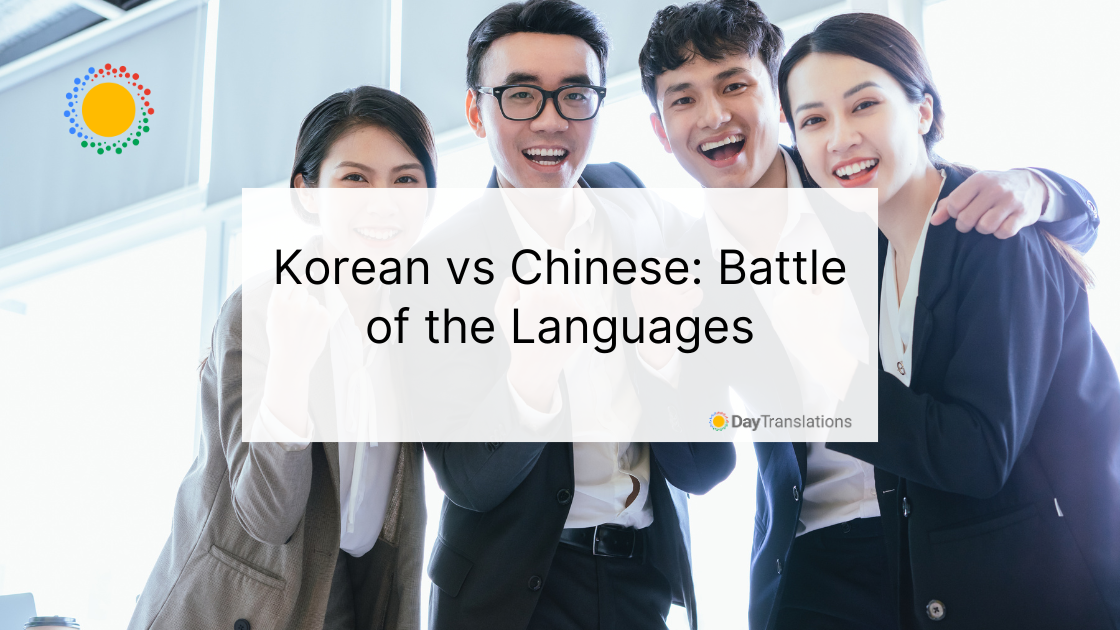South Korea and The People’s Republic of China are two very relevant players on the international stage. In the last decades, they’ve risen to a leading position as technological innovators, ever-growing cultural influencers, and industrial powerhouses.
The rise of K-pop has motivated thousands of American teens and young adults to take Korean classes, either after school or as part of their college education. In fact, between 2013 and 2016, the number of college students taking Korean lessons rose 14%.
On the other hand, China’s industrial power has driven many young professionals to see their future in this Asian country. As a consequence, many (for instance, the British Council, in its “Languages of the Future” report), pose that Mandarin Chinese will be one of the languages of the future.
In this post, we’ll do a side by side comparison, analyzing Korean vs Chinese grammar, pronunciation, and writing. As a conclusion, we’ll try to decide which language might be easier for an English speaker to learn.
Writing Systems
One of the most challenging parts of learning Chinese is dealing with logograms. Chinese logograms usually correspond to syllables or morphemes (the smallest meaningful units in a language). A Chinese speaker only needs to recognize between 1500 and 2000 characters to be legally considered as fluent. A highly educated Chinese person usually knows about 8000 – merely a fraction of the language’s 50,000 total characters.
In this blog, polyglot Steve Kaufman explains that, when trying to learn Chinese, he decided to start with the 1000 most common characters. He used flashcards and training books for schoolchildren, to get used to these characters and learn how to write them.
It’s often recommended that those that find language learning a little bit trickier than seasoned polyglots like Kaufman, should prioritize learning to recognize and read these characters, over learning how to write them.
Korean, by its part, doesn’t have characters representing syllables or morphemes, but what we know as letters. Each character is equal to a letter. The Hangul alphabet is far less daunting than its Chinese counterpart, with just 24 phonemes: 14 consonants and 10 vocals.
Syntax & Grammar
Chinese grammar is far more strict and straightforward than its Japanese and Korean counterparts. On the other hand, Chinese sentences tend to have the Subject-Verb-Noun structure we’re used to in English.
This is not the case for Korean, which has a far more convoluted grammar that’s very similar to Japanese’s.
Honorifics, conjugations, and particles (which determine a word’s role in a sentence) can make Korean grammar harder to grasp.
On the other hand, Korean has “합성어 (hapseongeo)”, compound words or word families.
Word families are series of words that share a certain element and are therefore easy to predict. As language-learning blog “90-Day Korean” notes in their tips to learn Korean fast, a clear example can be found when we talk about languages. The Korean for “Japanese Language” is “일본어 (ilboneo)”.
“일본 (ilbon)” means “Japan”. If we want to turn “Japan” into “Japanese Language”, we just need to add the “어 (eo)” syllable. Let’s say we want to refer to German instead. Germany is “독일 (dogil)”. Therefore, the “German Language” is “독일어 (dogireo)”.
Pronunciation
In both writing and pronunciation, Hangul has a very similar logic to what a native speaker of a Romance or Germanic language is used to.
But, aside from the challenge of deciphering how each Hanzi character sounds, we shouldn’t forget that Chinese has four intonations (and an extra neutral one). And, with each intonation, meaning and intention vary. This, among other factors, sets a very high fluency threshold for Chinese interpreter and translators. While Korean translation services providers should always have a high degree of familiarity with the language, a low-skilled Chinese translator or interpreter misinterpreting intonation could result in a disaster.
Korean vs Chinese: Which one’s the easiest to learn?
In conclusion, the Mandarin Chinese writing system is far more complex than its Korean counterpart. Hangul is far easier to learn than Hanzi.
But, while Chinese grammar is rather predictable and stable, Korean grammar has some extra layers of difficulty. These challenges can be overcome by recognizing patterns, which exist in Korean as in any other language.
On the other hand, Korean pronunciation is far more predictable and straightforward than that of the Chinese language, which involves tones that affect a sentence’s intention and meaning and may be hard to master. While Mandarin Chinese has four tones, dialects such as Lukang Township Taiwanese have as many as eight.
Generally speaking, we might assert that Korean is easier for an English speaker to learn than Mandarin Chinese. But this is very relative. In fact, the US Foreign Service Institute assigns Mandarin Chinese and Korean the same level of difficulty. Both languages are in “Category Four”. This means they’re both exceptionally difficult for English speakers to learn.
But, if you accept the challenge of learning one (or both) of these beautiful languages, you’ll discover two rich and enthralling cultures, meet new people in the process, and maybe even get the professional opportunity of your dreams.












Sorry, the comment form is closed at this time.